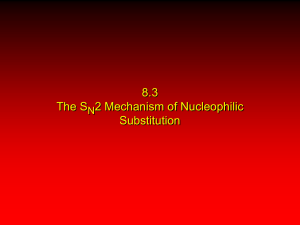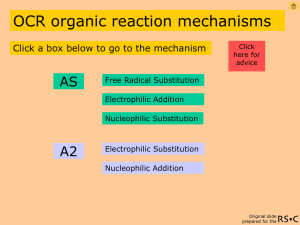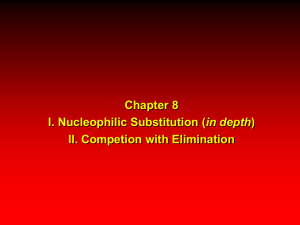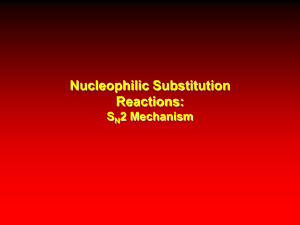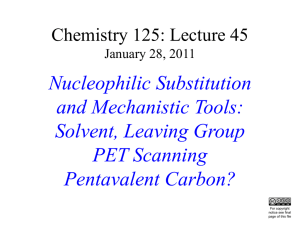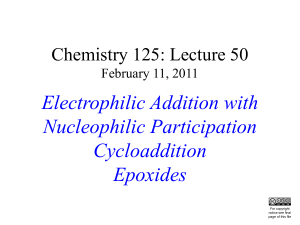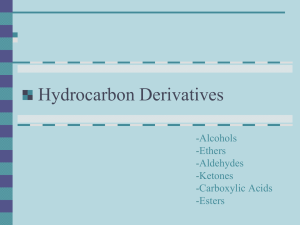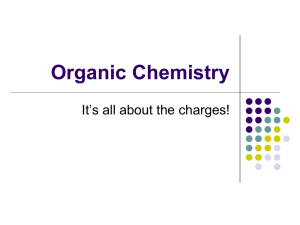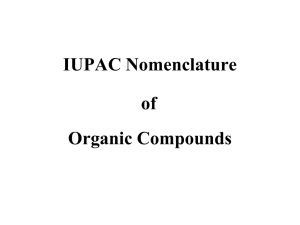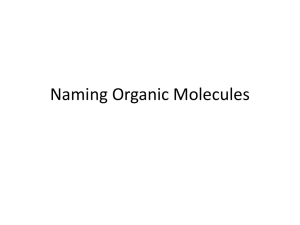Ch10-Sn2 - ChemConnections
advertisement
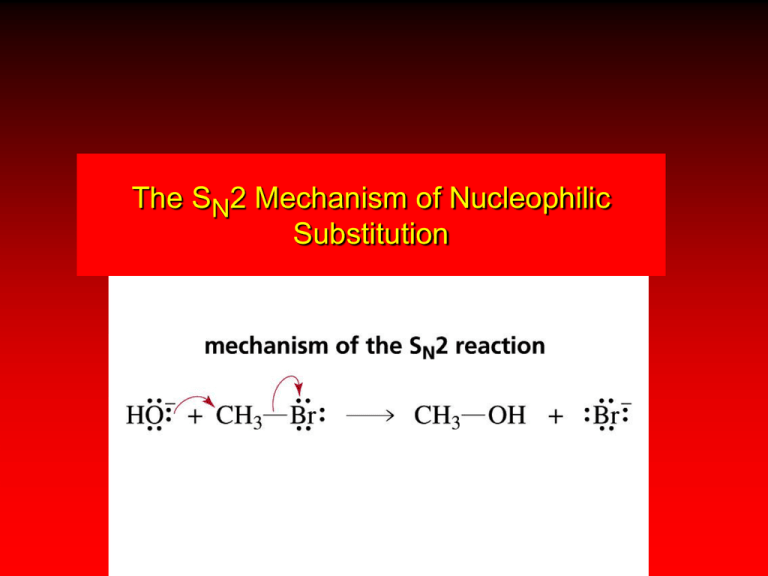
The SN2 Mechanism of Nucleophilic Substitution QuickTime™ and a Sorenson Video decompressor are needed to see this picture. Kinetics Many nucleophilic substitutions follow a second-order rate law. CH3Br + HO – CH3OH + Br – rate = k [CH3Br] [HO – ] What is the reaction order of each starting material? What can you infer on a molecular level? What is the overall order of reaction? Bimolecular mechanism one step concerted HO – + CH3Br HOCH3 + Br – Bimolecular mechanism one step concerted HO – + CH3Br HOCH3 + Br – Bimolecular mechanism dHO dBr CH3 transition state one step concerted HO – + CH3Br HOCH3 + Br – Stereochemistry of SN2 Reactions Generalization QuickTime™ and a YUV420 codec decompressor are needed to see this picture. Nucleophilic substitutions that exhibit second-order kinetic behavior are stereospecific and proceed with inversion of configuration. Inversion of Configuration nucleophile attacks carbon from side opposite bond to the leaving group Inversion of Configuration nucleophile attacks carbon from side opposite bond to the leaving group three-dimensional arrangement of bonds in product is opposite to that of reactant Inversion of configuration (Walden inversion) in an SN2 reaction is due to back side attack Stereospecific Reaction A stereospecific reaction is one in which stereoisomeric starting materials give stereoisomeric products. The reaction of 2-bromooctane with NaOH (in ethanol-water) is stereospecific. (+)-2-Bromooctane (–)-2-Octanol (–)-2-Bromooctane (+)-2-Octanol Stereospecific Reaction H (CH2)5CH3 CH3(CH2)5 H NaOH C Br CH3 (S)-(+)-2-Bromooctane HO C CH3 (R)-(–)-2-Octanol 1) Draw the Fischer projection formula for (+)-S-2-bromooctane. 2) Write the Fischer projection of the (–)-2-octanol formed from it by nucleophilic substitution with inversion of configuration. CH3 H CH3 Br CH2(CH2)4CH3 HO H CH2(CH2)4CH3 R- or S- ? A conceptual view of SN2 reactions Why does the nucleophile attack from the back side? CH3(CH2)5 H –.. C HO .. H3C .. Br .. : CH3(CH2)5 d.. – HO .. H C CH3 CH3(CH2)5 H –.. C HO .. H3C .. Br .. : .. d – Br .. : CH3(CH2)5 d.. – HO .. H .. d – Br .. : C CH3 CH3(CH2)5 H –.. C HO .. H3C .. Br .. : .. HO .. H (CH ) CH 2 5 3 .. – C Br .. : CH3 Steric Effects in SN2 Reactions Crowding at the Reaction Site The rate of nucleophilic substitution by the SN2 mechanism is governed by steric effects. Crowding at the carbon that bears the leaving group slows the rate of bimolecular nucleophilic substitution. Reactivity toward substitution by the SN2 mechanism RBr + LiI RI + LiBr Alkyl bromide Class Relative rate CH3Br Methyl 221,000 CH3CH2Br Primary 1,350 (CH3)2CHBr Secondary 1 (CH3)3CBr Tertiary too small to measure A bulky substituent in the alkyl halide reduces the reactivity of the alkyl halide: steric hindrance Decreasing SN2 Reactivity CH3Br CH3CH2Br (CH3)2CHBr (CH3)3CBr Decreasing SN2 Reactivity CH3Br CH3CH2Br (CH3)2CHBr (CH3)3CBr Reaction coordinate diagrams for (a) the SN2 reaction of methyl bromide and (b) an SN2 reaction of a sterically hindered alkyl bromide Crowding Adjacent to the Reaction Site The rate of nucleophilic substitution by the SN2 mechanism is governed by steric effects. Crowding at the carbon adjacent to the one that bears the leaving group also slows the rate of bimolecular nucleophilic substitution, but the effect is smaller. Effect of chain branching on rate of SN2 substitution RBr + LiI RI + LiBr Alkyl bromide Structure Relative rate Ethyl CH3CH2Br 1.0 Propyl CH3CH2CH2Br 0.8 Isobutyl (CH3)2CHCH2Br 0.036 Neopentyl (CH3)3CCH2Br 0.00002
